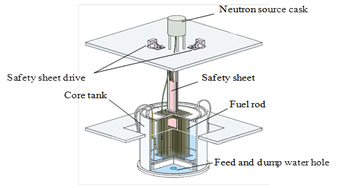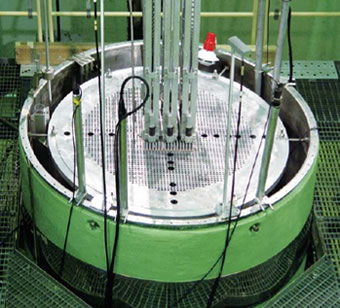TCA
◎ Purpose and outline of the facility
TCA (Tank-type Critical Assembly) is a critical assembly for the study of reactor physics and criticality safety of light water reactors (LWRs).
The reactor core of TCA is constructed by vertically arranging fuel rods in the 1.8-m diameter core tank. Light water is fed to the core from the feed and dump water hole at the bottom of the tank. The reactor is mainly controlled by adjusting the tank’s water level.
◎ R&D activities
The TCA experiments have been conducted mainly for the research and development of LWR criticality safety and training of nuclear engineers.
Future experiments will be conducted to confirm the validity of the detailed design of the modified STACY, which is expected to be used for the R&D of reactor decommissioning of the Fukushima Daiichi Nuclear Power Plant.
◎ Contributions
The criticality data accumulated through the TCA experiments over many years have been effectively utilized as experimental data for global standards in the field of nuclear criticality safety, and have contributed to the verification of the evaluation methods proposed in the nuclear criticality safety handbook. The TCA activities have also been used for professional training, which have contributed to the development of nuclear engineers.

A diagram of the TCA core tank

External view of the core tank (a vertically open and cylindrical tank)
◎ A brief history of TCA activities
| 1962.8 | First criticality |
| 1960 | Mock-up experiments for JPDR and “MUTSU” |
| 1970~ | Experiments for Pu-utilization and core improvement in LWRs |
| 1980~ | Reactor experiments for study on criticality safety and training of nuclear engineers |
◎ Major specifications:
| Name | Tank-type Critical Assembly (TCA) |
| Type | A vertically open and cylindrical tank |
| First Criticality | August 23, 1962 |
| Number of Operations | More than ten thousand |
| Dimensions of the core tank | Approximately 1.8 m in diameter and 2 m in height |
| Fuel | Enriched U and Pu |
| Maximum thermal power | 200 W |







